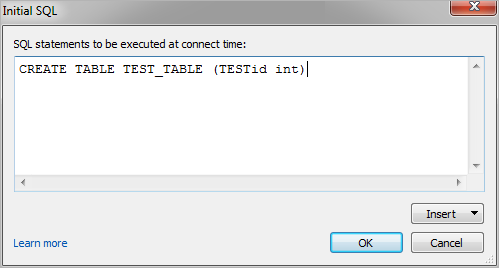
Note: Tableau Prep Builder version 2019.2.2 and later supports using Initial SQL, but doesn't yet support all of the same options supported by Tableau Desktop For information about using Initial SQL with Tableau Prep Builder, see Use Initial SQL to query your connections (Link opens in a new window) in the Tableau Prep Builder Salesforce Help.
When connecting to some databases, you can specify an initial SQL command that will run or use a cached value when a connection is made to the database, for example, when you open the workbook, refresh an extract, sign in to Tableau Server, or publish to Tableau Server.
Note: Initial SQL is different than a custom SQL connection. A custom SQL connection defines a relation (or table) to issue queries against. For more information, see Connect to a Custom SQL Query.
You can use this command to:
You have the option to add an initial SQL command in the Server Connection dialog box or on the Data Source page.
Note: If your data source supports running an initial SQL statement, an Initial SQL link appears in the lower-left corner of the Server Connection dialog box. For information about your data source, see Supported Connectors.

Note: Tableau doesn't examine the statement for errors. This SQL statement is sent to the database when you connect.
Your software license may restrict you from using initial SQL with your connection. If you publish to Tableau Server, the server must be configured to allow Initial SQL statements. By default, the server software is configured to allow these statements to run when the workbook is loaded in a web browser.
Administrators can configure the server to ignore initial SQL statements by using the tsm configuration set command:
tsm configuration set -k vizqlserver.initialsql.disabled -v true
If the server doesn't allow initial SQL statements, the workbook opens, but the initial SQL commands aren’t sent.
For more information about the tsm configuration set command, see the Tableau Server Help (Link opens in a new window) .
You can pass parameters to your data source in an initial SQL statement. The following list has several benefits of using parameters in a initial SQL statement.
The following parameters are supported in an initial SQL statement:
Tableau Desktop Professional
Warning: Tableau Desktop doesn't include domain. You can include it if you aren't using delegation and you set tsm configuration set -k DelegationUseFullDomainName=-v true--force-keys
The following examples show different ways you can use parameters in an initial SQL statement.
You can defer an initial SQL statement so that it’s executed only on the server. One reason to defer execution to the server is if you don’t have permission to execute the commands that set up impersonation. Use tags to enclose the commands to be executed only on the server.
CREATE TEMP TABLE TempTable(x varchar(25)); INSERT INTO TempTable VALUES (1);INSERT INTO TempTable Values(2);
When you use the TableauServerUser or TableauServerUserFull parameter in an initial SQL statement, you’ll create a dedicated connection that can’t be shared with other users. This can also restrict cache sharing, which can enhance security, but may also slow performance.
After you connect to MySQL and run an initial SQL statement, the tables might not show because of the way Tableau constructs the query.
CREATE TABLE TestV1.testtable77(testID int);
To resolve this issue, add IF NOT EXISTS to the SQL statement:
CREATE TABLE IF NOT EXISTS TestV1.TestTable(testID int);
After you connect to Oracle and run an initial SQL statement, Tableau is stalled with a spinning wheel because of the way Tableau constructs the query.
CREATE TABLE TEST_TABLE (TESTid int)
To resolve this issue, use the following SQL statement:
BEGIN EXECUTE IMMEDIATE 'create table test_table(testID int)'; EXCEPTION WHEN OTHERS THEN NULL; END;